There are a lot of flowers whose names begin with A. While many of them can be planted anywhere, the majority are only found in certain regions of the world.
Furthermore, these flowers offer unique nutrients that are used for a variety of things.
Almost everyone who inhabits the planet has a favorite flower. However, there are many of them that you might not be familiar with.
From Aloe to Azalea: Exploring 20 Astonishing Plants Starting with A

These are the top flowers or plants, all of whose names begin with the letter “A.”
- Aloe vera
- Azalea
- African violet
- Acanthus
- Agapanthus
- Ageratum
- Allium
- Alyssum
- Amaranth
- Anemone
- Angel’s trumpet
- Anthurium
- Arum Lily
- Asparagus fern
- Aster
- Aubrieta
- Aztec grass
- Abelia
- Abutilon
- Achillea (Yarrow)
- Adenium (Desert Rose)
- Aeschynanthus (Lipstick Plant)
- Aglaonema (Chinese Evergreen)
- Alstroemeria (Peruvian Lily)
- Amsonia (Blue Star)
- Andromeda
- Anigozanthos (Kangaroo Paw)
- Aralia
- Armeria (Thrift)
- Artemisia
- Asclepias (Milkweed)
- Aspidistra (Cast Iron Plant)
- Aucuba (Japanese Laurel)
- Aurinia (Basket of Gold)
- Azara (Boxleaf Azara).
Arum
Arum (also known as Arum Lilies) is a genus of flowering plants with the largest species diversity, with roughly 32 distinct species in the family Araceae. It is most frequently found in North Africa, Europe, Western Asia, and Central Asia.
The flowers on its plants are distinctive, and several of them have leaves in the shape of arrows.
Abelia
There are roughly 30 species of both deciduous and evergreen shrubs in the Abelia genus, which is well-known for its vivid leaves and protracted bloom seasons. The Abelia genus has been the subject of much debate because recent DNA analysis has revealed that several previously accepted members of the genus were actually quite distinct.
There are several popular ways to identify the shrubs referred to as “abelia.” The leaves of these shrubs are pointy, oval-shaped, frequently yellow or green, with orange, pink, bronze, or burgundy accents.
Acoma Crape Myrtle
The Acoma crape myrtle, sometimes known as the crape (or crepe) myrtle, is a hybrid variant of Lagerstroemia. This particular cultivar grows to a maximum height of 10 to 15 feet while maintaining a more shrub-like growth pattern. A properly loved and cared crape myrtle can live for at least 50 years and grows at a rate of 1 to 2 feet each year.
Crape myrtles from Acoma are a fantastic choice for planting in urban or suburban areas. Due to its little size, it is perfect for gardens and lawns. It may also be used in a landscaping strategy for businesses.
Aeonium
Aeonium is a genus of roughly 35 succulent plants distinguished by their rosettes of highly shiny, waxy leaves. The species, which are also known as tree houseleeks, include the small A. tabuliforme and A. smithii as well as the bigger A. arboreum, A. valverdense, and A. holochrysum that can reach heights of several feet.
Aeoniums can be cultivated inside or in the garden at any season. The small bunches of flowers that emerge from the centers of the rosettes take up to five years to develop on these somewhat slow-growing plants.
Aerangis Orchids
The magnificent white, star-shaped blossoms set the Aerangis genus tropical orchids apart from one another. About 50 different species of plants belong to this genus; most of them are endemic to tropical areas of Africa, although a few are also found on islands in the Indian Ocean. Despite being rarely grown, aerangis orchids are not unduly challenging to grow, especially for beginners.
These orchids are typically epiphytes, which means they grow on trees rather than in soil. They are frequently planted in hanging baskets filled with a bark chip/sphagnum moss mixture.
African Daisy
African daisies (Osteospermum spp.) have petals that radiate out from a central disk, similar to common daisies. They belong to the same family as zinnias and Shasta daisies, the Asteraceae. However, their vibrant color is nothing like the traditional daisy. In fact, some consumers believed African daisies must have been colored when they were initially introduced on the market.
These flowers grow rather quickly, flowering around two months after emerging from seeds, and are best planted in the spring once the risk of frost has passed.
African Fern Pine
Eastern Africa is home to the conifer known as the African fern pine (Afrocarpus gracilior), which has long, narrow leaves. The fern pine develops clumps of thin, light-green leaves that gradually turn darker with age. The evergreen leaves mature to a maximum length of 4 inches and are unevenly spaced. This hedge shrub or tree is attractive due to the airy, fern-like appearance of the leaf. This species’ flowers are unassuming and yellow.
Fern pines grow a single upright trunk and a thick canopy that, when skillfully pruned, gives the tree a rounded or oval shape. Whether it develops into a tree or a hedge will determine its height. If let to develop into a tree, it will eventually grow to a height of up to 60 feet.
African Iris
The African Iris (Dietes iridioides) is an evergreen plant with a lengthy flowering season from spring to fall. It thrives in warmer climates. This plant is South African in origin. It has strappy, elongated, blue-green leaves that are upright all season long. In zones 8 to 11, it can be grown as a perennial, but in colder climates, it’s usually grown as an annual. Its taxonomy categorization has changed slightly over time, and it is also occasionally referred to as Dietes grandiflora.
This lovely plant includes a round, six-petaled creamy white blossom with vivid yellow accents running down the center, as well as a smaller, four-petaled blue-purple flower that appears in the center.
African Mask
Southeast Asian native Amazonian elephant’s ear is a well-liked tropical plant. It is a hybrid variety that is frequently marketed as a stunning and lovely houseplant. It is a year-round indoor plant that may be bought, planted, and maintained.
The deep green leaves of the Amazonian elephant’s ear are distinctive and are highlighted by whitish or light green veins. The leaves have coarse serrations, and occasionally they have an almost purple-green hue. The plant will mature at a height of up to 2 feet and develop swiftly.
African Milk Tree
Central Africa is the original home of the African milk tree (Euphorbia trigona). Because of its fervent and quick growth, it is frequently used as a hedge. Although it has names like “cathedral cactus,” “candelabra cactus,” “friendship cactus,” and “good luck cactus,” this plant is essentially a succulent. It has three unique sides that are ridged and have triangular stems. Thorns and teardrop-shaped leaves are scattered over the ridges.
African milk tree has a long lifespan and grows quickly, gaining 1 to 2 feet per year and reaching a height of 9 feet. However, this plant will only reach around half of its maximum height when planted indoors.
African Spear Plant
The cylindrical snake plant, commonly known as the African spear plant (Sansevieria cylindrica), is a succulent with upright, gray-green, faintly striped leaves. The shape of the leaves is cylindrical, but at the tips, they are pointed. A tall flower spike filled with tiny, delicate white blossoms may emerge from the heart of an African spear plant when it is produced under ideal conditions. They grow slowly in general and are best planted in the spring at the beginning of the growing season.
Agapanthus
Six species of perennial plants in the genus Agapanthus have colorful bell-shaped blooms. They often bloom in hues of pink, blue, purple, and white, frequently with a darker center stripe on each petal, from early summer till October. Tall stalks with flowers atop them bear long, wide-ranging leaves. Depending on the type, the leaves can be either evergreen or deciduous and range in hue from dark to light green, gray-green, or blue-green.
Hummingbirds are drawn to agapanthus blossoms, which also make wonderful cut flowers and are often deer and rabbit resistant. Agapanthus is poisonous to both people and animals.
- Vegetables That Start With A.
- Birds That Start With A.
- Animals That Start With A.
- Foods That Start With A.
- Fruits That Start With A.
Join 25,000+ smart readers—don’t miss out!







